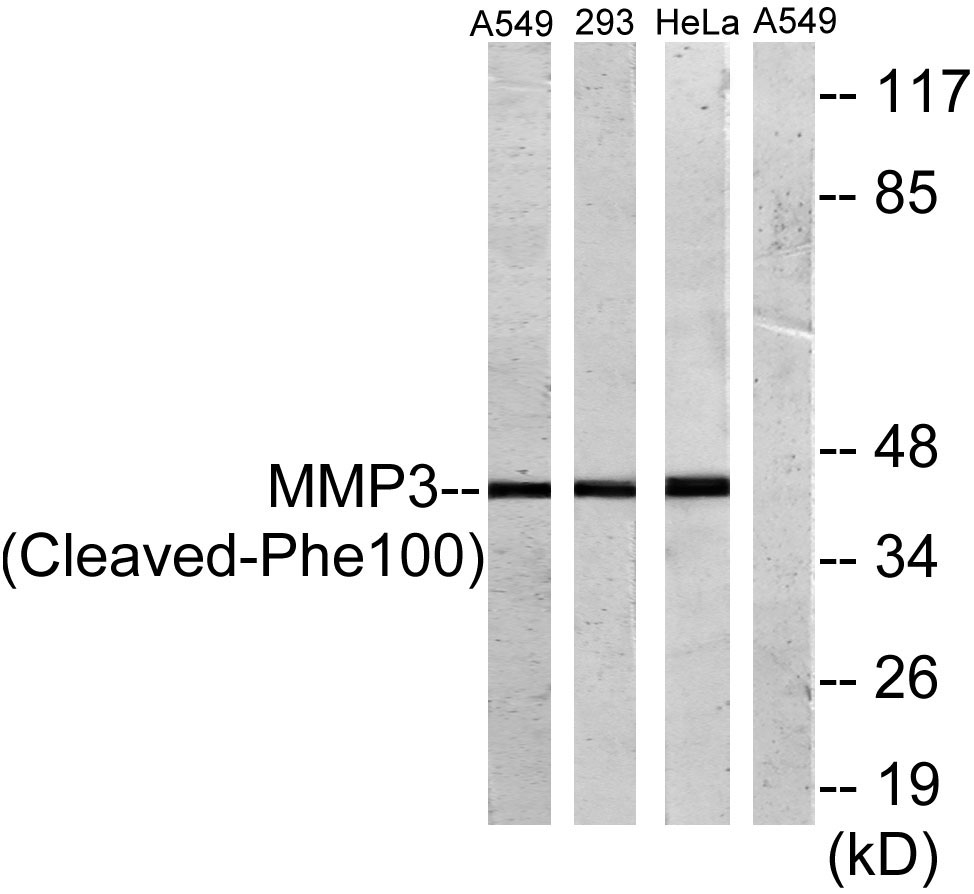Cleaved-MMP-3 (F100) Polyclonal Antibody
- Catalog No.:YC0066
- Applications:WB;ELISA
- Reactivity:Human;Rat;Mouse;
- Target:
- MMP-3
- Fields:
- >>IL-17 signaling pathway;>>TNF signaling pathway;>>Coronavirus disease - COVID-19;>>Transcriptional misregulation in cancer;>>Prostate cancer;>>Rheumatoid arthritis;>>Lipid and atherosclerosis
- Gene Name:
- MMP3
- Protein Name:
- Stromelysin-1
- Human Gene Id:
- 4314
- Human Swiss Prot No:
- P08254
- Mouse Swiss Prot No:
- P28862
- Immunogen:
- The antiserum was produced against synthesized peptide derived from human MMP3. AA range:81-130
- Specificity:
- Cleaved-MMP-3 (F100) Polyclonal Antibody detects endogenous levels of fragment of activated MMP-3 protein resulting from cleavage adjacent to F100.
- Formulation:
- Liquid in PBS containing 50% glycerol, 0.5% BSA and 0.02% sodium azide.
- Source:
- Polyclonal, Rabbit,IgG
- Dilution:
- WB 1:500 - 1:2000. ELISA: 1:20000. Not yet tested in other applications.
- Purification:
- The antibody was affinity-purified from rabbit antiserum by affinity-chromatography using epitope-specific immunogen.
- Concentration:
- 1 mg/ml
- Storage Stability:
- -15°C to -25°C/1 year(Do not lower than -25°C)
- Other Name:
- MMP3;STMY1;Stromelysin-1;SL-1;Matrix metalloproteinase-3;MMP-3;Transin-1
- Observed Band(KD):
- 43kD
- Background:
- matrix metallopeptidase 3(MMP3) Homo sapiens Proteins of the matrix metalloproteinase (MMP) family are involved in the breakdown of extracellular matrix in normal physiological processes, such as embryonic development, reproduction, and tissue remodeling, as well as in disease processes, such as arthritis and metastasis. Most MMP's are secreted as inactive proproteins which are activated when cleaved by extracellular proteinases. This gene encodes an enzyme which degrades fibronectin, laminin, collagens III, IV, IX, and X, and cartilage proteoglycans. The enzyme is thought to be involved in wound repair, progression of atherosclerosis, and tumor initiation. The gene is part of a cluster of MMP genes which localize to chromosome 11q22.3. [provided by RefSeq, Jul 2008],
- Function:
- catalytic activity:Preferential cleavage where P1', P2' and P3' are hydrophobic residues.,cofactor:Binds 2 zinc ions per subunit.,cofactor:Binds 4 calcium ions per subunit.,domain:The conserved cysteine present in the cysteine-switch motif binds the catalytic zinc ion, thus inhibiting the enzyme. The dissociation of the cysteine from the zinc ion upon the activation-peptide release activates the enzyme.,function:Can degrade fibronectin, laminin, gelatins of type I, III, IV, and V; collagens III, IV, X, and IX, and cartilage proteoglycans. Activates procollagenase.,similarity:Belongs to the peptidase M10A family.,similarity:Contains 4 hemopexin-like domains.,
- Subcellular Location:
- Secreted, extracellular space, extracellular matrix .
- Expression:
- Fibroblast,Lung,Synovium,
- June 19-2018
- WESTERN IMMUNOBLOTTING PROTOCOL
- June 19-2018
- IMMUNOHISTOCHEMISTRY-PARAFFIN PROTOCOL
- June 19-2018
- IMMUNOFLUORESCENCE PROTOCOL
- September 08-2020
- FLOW-CYTOMEYRT-PROTOCOL
- May 20-2022
- Cell-Based ELISA│解您多样本WB检测之困扰
- July 13-2018
- CELL-BASED-ELISA-PROTOCOL-FOR-ACETYL-PROTEIN
- July 13-2018
- CELL-BASED-ELISA-PROTOCOL-FOR-PHOSPHO-PROTEIN
- July 13-2018
- Antibody-FAQs
- Products Images

- Western Blot analysis of various cells using Cleaved-MMP-3 (F100) Polyclonal Antibody

- Western blot analysis of lysates from A549, 293, and HeLa cells, treated with etoposide 25uM 24h, using MMP3 (Cleaved-Phe100) Antibody. The lane on the right is blocked with the synthesized peptide.



